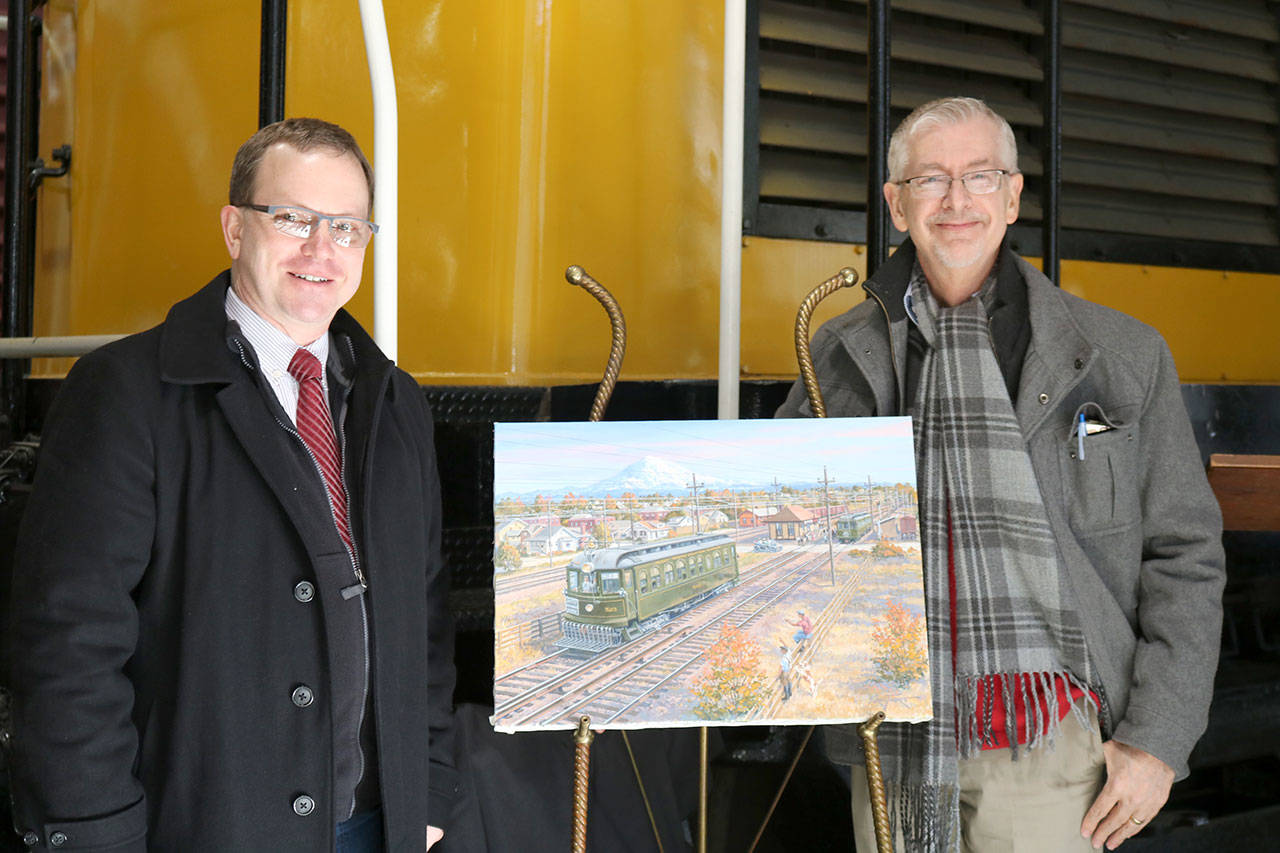To commemorate the recent acquisition of a 110-year-old electric train car, the Northwest Railway Museum unveiled a painting titled “The Story Teller” commissioned by local artist J. Craig Thorpe at their Train Shed exhibit building on Thursday, Feb. 22.
Executive Director of the museum, Richard Anderson, spoke to a crowd of staff, partners and visitors at the presentation to introduce the Interurban car 523 as well as the painting the museum commissioned for display.
Built in 1907, Car 523 is the last-known surviving Puget Sound Electric Rail Interurban car, Anderson said. Car 523 began its run at the electric railway as a parlor car, but eventually was outfitted with its own electric engine.
Interurban cars connected the urban centers to the outlying communities, including Seattle, Tacoma, Auburn, Milton and Fife. The day of the presentation, Anderson said, was also the 110th anniversary of the introduction of the parlor car service on the PSER.
Anderson said he had heard of the car many years ago, but it was being preserved in Petaluma, Calif. and he didn’t think retrieving and restoring it would be a viable project for the museum. However, the owner of the car approached the Northwest Railway Museum to ask if the museum would accept the car as a donation. With the help of a 4Culture grant of $11,000, the museum arranged for the car to be trucked up to Washington; it arrived Sept. 21, 2017.
As part of the outreach effort for the restoration of Car 523, the museum commissioned a painting of it at the Auburn station in 1915 from Thorpe, a landscape artist who specializes in architectural and railroad work. Thorpe, Anderson and the rest of the museum staff helped to research the interurban car to determine how to accurately portray the setting of the painting. Anderson suggested the Auburn station as it was a transition point from the overhead electric wires that powered the car in urban centers to the grounded third rail, which ran along the ground next to the tracks in the countryside.
“The art gives me a chance to tell a story to help the visitors catch a glimpse of beauty and of relevance,” Thorpe said as the painting was revealed. “My thanks to the museum and its staff for understanding that role and commitment to make this piece of artwork really work.”
As for the train car itself, Anderson said they plan to restore the car to get it running on the tracks alongside their previous restoration project, the Messenger of Peace Chapel Car.
“We’d like to do a repeat performance on the 523. It’s remarkably similar in construction (to the chapel car), although it did have a different purpose,” he said. “It is our intent to demonstrate this car, to run it with electric motors and possibly a set of batteries to allow it to operate a short distance on the track up here. I think it’s particularly appropriate given that this car used to run with electricity from Snoqualmie Falls.”
Luckily, the car was in good condition, especially compared to the Chapel Car, Anderson said. He explained that the car was structurally sound, and had only a few minor issues. It had been preserved by its owner in 1963 and was kept either inside a warehouse or under a tarp in a dry climate.
Anderson said the restoration timeline is dependent on the speed of fundraising, but he is excited to begin the process of adding another car to the museum’s collection.
“The timeline is always difficult to predict because it’s always the variability at how effectively we can raise funding, but we anticipate this being a project cost of around $650,000 and that would be a complete rehabilitation where it is able to operate under its own power.”


